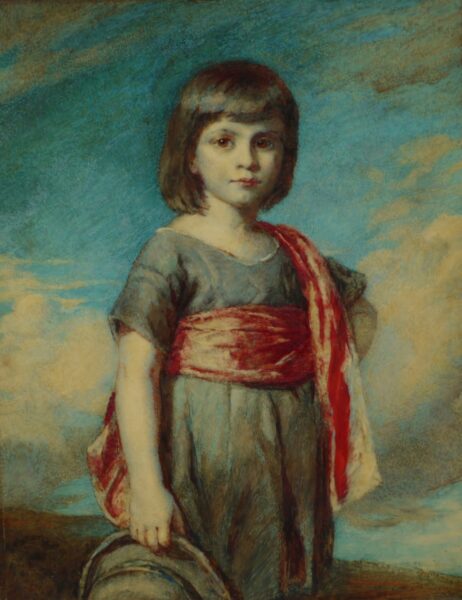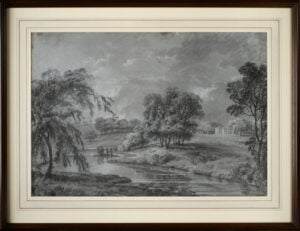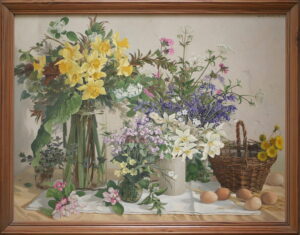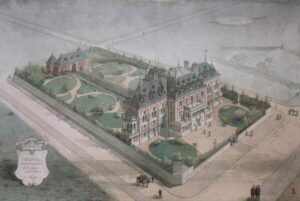Description
G.R replicated the miniature from a larger version of the subject he painted for the Bodleian Gallery, at Oxford, exhibited in 1854. The oil can be seen in one of the photos taken at George Richmonds residence: 10 York Street, Portman Square, Marylebone.

The following account gives us an insight into the character of Harry Inglis Richmond: [Thomas Anstey Guthrie, “A Long Retrospect”, 1936]
And there was Inglis, a younger brother of Richmond, an amiable voluble dilettante, with gifts that might have enabled him to distinguish himself in more than one profession but for his incurable indolence and the fact that he had been left a sum of money by a friend of his father’s which made it unnecessary for him to work. He had indeed been called to the Bar, and for a time was in chambers with William Fothergill Robinson, who told me that a client came to see him one day, and as he was leaving, said to Inglis, ‘Oh, by the way, Mr. Richmond, we’re sending you a case for opinion ? it’s a point on a bill of exchange.’ ‘Rweally?’ said Inglis, with his engaging lisp, ‘That’s verwy nice of you,’ and added brightly, ‘Tell me ? what is a bill of exchange?’ He was honestly anxious to know, but this was not likely to impress any solicitor with confidence, and I fancy Inglis was as much justified as I was in retiring early from practice.
He was a brilliant scholar, and great things had been expected of him both at Charterhouse and Oxford, but somehow he had never done them, and had settled down into a pleasant good-natured gossip and connoisseur, with a wonderful talent for mimicry. Inglis would give an imitation, for instance, of an old verger showing tourists round a French cathedral which was so lifelike as to have a touch of genius, and that was only one item in his repertoire.
This and other social qualities made him much in request, and he probably found his life agreeable enough as a rule, though I think there were times when he felt that it was rather a wasted one. I can see him now, a stout short figure, with a twinkle behind his single eye-glass, and a look of an omniscient jackdaw on his round face.
Brand
Richmond, George (1809-1896)
George Richmond was born to Thomas and Ann Richmond on the 28th March 1809. A natural facility for draftsmanship revealed itself at an early age. He is one of the youngest students ever to have been admitted to the Royal Academy schools. The Academy permanent collection holds drawings made by Richmond while studying in the school of the Antique.
In 1825 he met William Blake and, along with Samuel Palmer and fellow student Edward Calvert, became devoted to the aging artist. The young men would come to refer to themselves as the Ancients. The group followed the artistic principles of Blake and worked to ideals inspired by renaissance painters, particularly Michelangelo and Dürer. The party retired to Palmer's country home at Shoreham during the late 1820's, residing together and developing their aesthetic theory. They lived simply and worked hard.
In 1831 Richmond married Julia Tatham, daughter of Charles Heathcote Tatham. The marriage was immediately central to his life and they were to have thirteen children, ten of whom survived into adulthood. The necessities resulting from such a large family compelled Richmond to change direction artistically. It was impossible to follow the eclectic road taken by the Ancients and feed all the hungry mouths. The ramifications of this situation remained with Richmond for the rest of his professional life.
Richmond was an extremely religious young man. His beliefs chimed with the growth of evangelical devotion and he found a fellow communion among the members of the "Clapham Sect". Sir Robert Inglis was an early supporter of Richmond, and benefactor to the children of Henry Thornton, one of the founders of the Clapham group. It was through Inglis that Richmond received an important commission in 1832. Richmond landed a coup in painting the great emancipator, William Wilberforce. The positive public response to this portrait established Richmond, almost overnight, with a successful portrait practice.
From the early 1830's portrait painting became Richmond's primary source of income. By the late 1830's his financial security was such that he could afford to travel to Italy with his young family and that of Samuel Palmer. Richmond's experiences in Italy are recorded in his journals, which comprise part of this archive.
Richmond rarely left Britain after a second journey to Rome in 1840-1841. He worked hard over the next forty years, painting around 2500 of the most prominent figures of Victorian society. His learning in art practice and art history led him to be considered one of the country's foremost experts on painting restoration. This discipline took on more importance for him as his energies for portrait work flagged in the 1870's and 1880's. His residence, Porch House, in Potterne, Wiltshire, was regarded as a model of sensitive architectural restoration. He declined the position of director of the National Gallery at least once, citing ill health. Health was a perennial concern of this long-lived hypochondriac.
Julia Richmond died in 1881 and from this point Richmond entered the last, relatively secluded phase of his life. His closeness to the survivors of the Thornton clan is particularly evident towards the close of his life. Richmond died in 19th March 1896; having seen his son William Blake Richmond elected a Royal Academician the year before.




